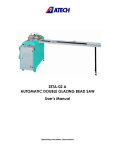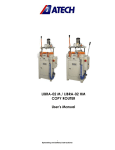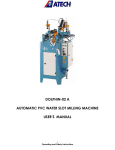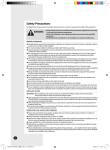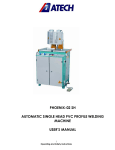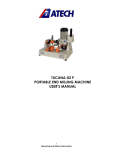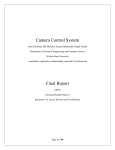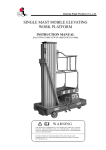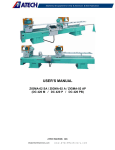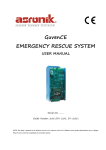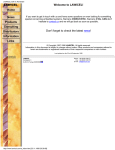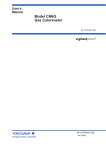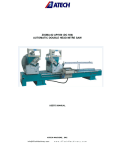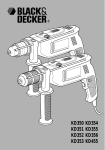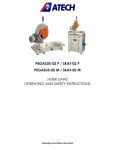Download norma-02 sa semi-automatic double head miter saw user`s manual
Transcript
NORMA-02 SA SEMI-AUTOMATIC DOUBLE HEAD MITER SAW USER’S MANUAL 1 Operating and Safety Instructions CONTENTS Page 1. General Information 1.1. Introduction 1.2. Manufacturer 2. Machine’s Description and Purpose of Use 2.1. Machine’s description 2.2. Technical features 2.3. Overall dimensions 2.4. Cutting diagram 2.5. Part lists and technical drawings 3. Safety 3.1. Safety information 3.2. Accident prevention 3.3. General safety information 4. Transport of the Machine 5. Installation of the Machine 5.1. Preparation 5.2. Electric connection 5.3 Air pressure adjustments 6. Machine Safety Information 7. Operation 7.1. General working information 7.2. Dimensional and angular adjustments 7.3. Cutting speed adjustment 7.4. Cutting operation 7.4.1. Double head cutting 7.4.2. Single head cutting 8. Safe Installation of the Saw Blade 9. Replacement of Display Battery 10. Maintenance 10.1. Periodic checks 10.2. Maintenance at the end of working day 11. Troubleshooting Guide 12. Electric / Pneumatic Components 12.1 Electric components 12.2. Pneumatic components 2 Operating and Safety Instructions 3 3 3 3 3 5 6 7 8 9 9 10 11 12 13 13 13 14 15 16 16 16 18 18 18 19 20 21 22 22 22 23 24 24 25 1. GENERAL INFORMATION 1.1. INTRODUCTION The user’s manual given by the manufacturer contains necessary information about the machine parts. Each machine operator should read these instructions carefully, and the machine should be operated after fully understanding them. Safe and efficient use of the machine for long term depends on understanding and following the instructions contained in this manual. The technical drawings and details contained in this manual constitute a guide for the operator. 1.2. DISTRIBUTOR ATech Machine, Inc. 10752-A Tucker Street – Beltsville, MD 20705 USA Phone: +1-301-595-1816 Fax: +1-301-560-6627 Website: www.ATechMachinery.com E-mail: [email protected] In case of any technical problem please contact your nearest ATECH dealer, or ATECH head office through the above mentioned phone, fax or e-mail address. Technical labels with the model description of the machine are fixed onto the front side of each machine. The machine’s serial number and manufacturing year are stipulated on the technical label. 2. MACHINE’S DESCRIPTION and PURPOSE OF USE 2.1 MACHINE’S DESCRIPTION Double head miter saw with circular saw blades designed for double head, single head and straight or angular cutting of PVC, aluminum and wooden profiles. The saw blade movement is hydro-pneumatically, and it is possible to adjust the movement speed of the saw blade precisely according to the material to be cut. The clamps operate pneumatically, operating at low pressure and with both hands occupied for safety reasons. The left cutting head is fixed, while the right head is movable manually. The right head is equipped with a pneumatic braking system. For the operator’s safety, the machine does not work with the brake key OPEN. 3 Operating and Safety Instructions Measurements can be taken precisely with the digital read-out system. Cutting at fixed angles of 15º-22.5º-30º-45º-90º, and at any intermediate angle through a fixing handle. The machine has been designed according to the European CE Safety Directives. Please include the below mentioned data in all your correspondence regarding the machine with the manufacturer and/or your ATECH dealer. *Machine model *Machine’s serial number *Voltage and frequency *Name of dealer where machine was purchased *Date of purchase *Description of the machine fault *Average daily operation period Movable Head Fixed Head Control Panel Frame 4 Operating and Safety Instructions 2.2 TECHNICAL FEATURES Technical Features (American) Norma-02 SA 14" 2.2kW x 2 440V 60Hz D=14” d=1.18 – 1.26” 3000 rpm 90-120 psi 2.5 CFM 158x47x59” 1034 lb Norma-02 SA 16" 2.2kW x 2 440V 60Hz D=16” d=1.18 – 1.26” 3400 rpm 90-120 psi 2.5 CFM 158x47x59” 1100 lb Technical Features (Metric) Norma-02 SA 350 mm 2,2kW x 2 400V 50Hz D=350 mm d=30-32 mm 3000 rpm 90-120 psi 2.5 CFM 400x120x150 cm 470 kg Norma-02 SA 400 mm 2,2kW x 2 400V 50Hz D=400 mm d=30-32 mm 3400 rpm 90-120 psi 2.5 CFM 400x120x150 cm 500 kg -5– Operating and Safety Instructions 2.3. OVERALL DIMENSIONS -6– Operating and Safety Instructions 2.4. CUTTING DIAGRAM Max. 3455 mm (136”) Min. 530 mm (21”) -7– Operating and Safety Instructions 2.5. PART LISTS and TECHNICAL DRAWINGS NORMA PART LIST 8 Operating and Safety Instructions No PART NAME QTY No PART NAME QTY 7 111-247 MOVABLE FOOT 1 8 141-363 TABLE GUIDE SHAFT-2 1 48 191-005 6204 BEARING DIN 625 4 9 141-362 TABLE GUIDE SHAFT-1 1 50 114-003 BLADE INNER NUT WASHER 2 191-004 6203 BEARING DIN 625 8 51 141-092 BLADE WASHER 2 52 141-094 OUTER NUT WASHER 2 53 141-093 30x8x7 WASHER 2 54 172-026 M8x20 HEXAGONAL SCREW 2 2 55 201-004 CIRCULAR SAW BLADE 2 2 56 150-031 FORK SHEET 2 58 111-099 LOWER CLAMP HOUSING 4 60 141-285 UPPER CLAMP COLUMN SHAFT 2 19 112-031 BEARING COVER 141-118 CORE TIGHTENING ARM CONNECTION 141-119 CORE TIGHTENING ARM 141-114 TURNING TABLE LOWER CONNECTION 141-115 TURNING TABLE CONNECTION BOLT 150-001 LOWER CONNECTION WASHER 4 2 62 550-051 PNEUMATIC CLAMP CYLINDER 2 21 141-001 SNAP HOUSING 2 63 550-052 LOWER CLAMP CYLINDER 4 22 141-102 SNAP SHAFT 2 64 141-113 BLADE GUARD CONNECTION 2 24 550-069 BRAKE SYSTEM GROUP 1 65 111-169 GUARD HOUSING 2 34 112-030 FLYWHEEL 1 66 111-249 BLADE GUARD 1 35 111-063 SET SQUARE 2 67 150-002 GUARD ADAPTER 2 37 111-132 FORK 2 68 145-025 GUARD PLATE 2 39 111-248 HEAD 1 76 145-041 PISTON CONNECTION PLATE 2 2 163-002 2.2 kW MOTOR 2 77 150-032 PNEUMATIC CONNECTION SHEET 2 43 111-244 PULLEY GUARD 2 80 550- 006 HYDRO-PULL PISTON GROUP 2 44 112-105 BLADE SHAFT PULLEY 2 82 222-037 ENCODER GEAR 1 45 112-104 MOTOR SHAFT PULLEY 2 85 162-048 ENCODER 1 46 112-017 BEARING COVER 4 47 141-112 BLADE SHAFT 2 10 11 13 14 15 16 2 2 3. SAFETY 3.1. SAFETY INFORMATION The symbols shown hereunder are necessary to be read with special attention. Not reading or observing of them may cause damage to the equipment or personal injury. IMPORTANT The IMPORTANT symbol above is one telling to apply special care and to be careful at carrying out the specified operation. 9 Operating and Safety Instructions CAUTION ! The CAUTION! Symbol above warns you against specific dangers, and requires to read the text. Not observing may cause damage to the equipment. DANGER WARNING The above symbol DANGER WARNING, warns you against specific dangers, and you have definitely to read them. Negligence may cause damage to the equipment and bodily injury. Read the user’s manual carefully before using the machine or carrying out maintenance works. 3.2. ACCIDENT PREVENTION 3.2.1. Our machines are manufactured in accordance with EN 60204-1 and EN 292-2 CE safety directives, which cover national and international safety directives. 3.2.2. It is the task of the employer to warn his staff against accident risks, to train them on prevention of accidents, to provide for necessary safety equipment and devices for the operator’s safety. 3.2.3. Before starting to work with the machine, the operator should check the features of the machine, learn all details of the machine's operation. 3.2.4. Machine should be operated only by staff members, who have read and understood the contents of this manual. 3.2.5. All directives, recommendations and general safety rules contained in this manual have to be observed fully. The machine cannot be operated in any way for purposes other than those described herein. Otherwise, the manufacturer shall not be deemed responsible for any damages or injuries. And such circumstances would lead to the termination of the warranty. 10 Operating and Safety Instructions 3.3. GENERAL SAFETY INFORMATION 3.3.1. The power cable should be led in such a way that nobody can step on it or nothing can be placed on it. Special care has to be taken regarding the inlet and outlet sockets. 3.3.2. If the power cable should be damaged during operation, don't touch and unplug it. Never use damaged power cables. 3.3.3. Don’t overload machines for drilling and cutting. Your machine will operate more safely with power supply in accordance with the stipulated values. 3.3.4. Don’t place your hands between parts in motion. 3.3.5. Use protective eye glasses and ear plugs. Don't wear oversize clothes and jewels. These can be caught by moving parts. 3.3.6. Keep your working place always clean, dry and tidy for accident prevention and safe operation. 3.3.7. Use correct illumination for the safety of the operator. (ISO 8995-89 The Lighting of Indoor Work Systems) 3.3.8. Don't leave anything on the machine. 3.3.9. Don’t use any materials other than those recommended by the manufacturer for cutting operations on the machine. 3.3.10. Ensure that the work piece is clamped appropriately by the machine's clamp or vice. 11 Operating and Safety Instructions 3.3.11. Ensure safe working position, always keep your balance. 3.3.12. Keep your machine always clean for safe operation. Follow the instructions at maintenance and replacement of accessories. Check the plug and cable regularly. If damaged, let it replace by a qualified electrician. Keep handles and grips free of any oil and grease. 3.3.13. Unplug first, before conducting and maintenance works. 3.3.14. Ensure that any keys or adjustment tools have been removed before operating the machine. 3.3.15. If you are required to operate the machine outside, use only appropriate extension cables. 3.3.16. Repairs should be carried out by qualified technicians only. Otherwise, accidents may occur. 3.3.17. Before starting a new operation, check the appropriate function of protective devices and tools, ensure that they work properly. All conditions have to be fulfilled in order to ensure proper operation of your machine. Damaged protective parts and equipment have to be replaced or repaired properly (by the manufacturer or dealer). 3.3.18. Don’t use machines with improper functioning buttons and switches. 3.3.19. Don’t keep flammable, combustive liquids and materials next to the machine and electric connections. 4. TRANSPORT OF THE MACHINE IMPORTANT * The transport should be done by qualified personnel only. 4.1. The machine should be transported by lifting with proper equipment (not touching the ground during the transport). 4.2. The machine is delivered wrapped with nylon, unless other packaging method has been agreed upon with the customer. 4.3. For the weight and dimensions of the machine see Technical Features on Page 4. 12 Operating and Safety Instructions 5. INSTALLATION OF THE MACHINE The machine should be located so that at least 100 cm space remains between it and the rear wall. On the back side of the machine you will find connection tube for the collection of burr and swarf, hydro-pneumatic system, cable channels, power supply connection plug and the ENCODER counter of the digital read-out. The machine should be placed on even ground able to bear the weight of the machine. For the weight of the machine see Technical Features on Page 4. Figure-3 5.1. PREPARATION IMPORTANT 5.1.1 Dismantle the transport safety connection parts before starting the machine. (See Figure-5) Don’t connect power and air supply before dismantling the transport safety connection parts. 5.1.2 Save the dismantled transport safety connection parts for future transports of the machine. 5.2. ELECTRIC CONNECTION 5.2.1 Use only power cables in accordance with the CE Standards, cables of H07RNF type. 5.2.2 Check the power supply before switching the machine on. See Page 10, Item 6.2 13 Operating and Safety Instructions CAUTION ! * The electric connections have to be carried by qualified electricians only. Check the direction of the saw blade rotation. If the saw blade rotates in reverse direction, check the cable connections and re-connect if necessary. **A saw blade rotating in reverse direction causes danger both for the operator and the equipment. The teeth of the saw blade would be damaged and even broken. Transport Safety Connection -1 Transport Safety Connection-2 Figure-5 Figure-4 5.2.3 In order to ensure correct direction of the saw blade rotation, connect the machine to the power supply and follow the instructions below. a- Press the Start button. b- Press the Stop button. Observe the direction of the saw blade rotation from the open side of the guard. c- The correct direction of the saw blade rotation is shown in Figure 4. If the direction of saw blade rotation is wrong; The electric socket connections have to be checked by a qualified electrician and corrected accordingly. Don’t use the machine before ensuring the correct direction of the saw blade rotation. 5.3 AIR PRESSURE ADJUSTMENT For proper working of the pneumatic system the air pressure has to be between 7-8 Bar. Don’t operate the machine at an air pressure below 6 Bar. Read the manometer to check and adjust the air pressure. See Figure 6. Follow the instructions below for air pressure adjustments. 14 Operating and Safety Instructions 5.3.1 Pull the adjustment button of the conditioner upwards. 5.3.2 Turning the adjustment button in clockwise direction increases the pressure. Turning the adjustment button in counter clockwise direction decreases the pressure. 5.3.3 Once you read 7-8 Bar on the manometer, push the adjustment button of the conditioner down and lock it in that position. 5.3.4 The conditioner unit collects the water within the air system in a receptacle in order to prevent damage to the pneumatic system components. Discharge this water periodically (at the end of the working day) by pressing or opening the button under the conditioner. 5.3.5 The manufacturer recommends to use the following oils with the conditioner: TELLUS C 10 / BP ENERGOL HLP 10/ MOBIL DTE LIGHT / PETROL OFISI SPINDURA 10. Pressure Adjustment Button Oil Depot Manometer Oil Filling Cap Air Pressure and Water Discharge Screw Figure-6 6. MACHINE SAFETY INFORMATION 6.1 It is not allowed to operate the machine with the blade guards and other safety equipment removed. 6.2 Your machine operates at a voltage of 400V ~ 3-Phase 50 Hz (220V/440V 60Hz). Let the electric installation of the machine carry out by a qualified electrician. 6.3 Lifting, installation, electric and pneumatic maintenance works of the machine should be carried out by qualified personnel only. 15 Operating and Safety Instructions 6.4 Routine maintenance works and scheduled maintenance should be carried out only after disconnecting the power and pneumatic supply by qualified personnel. 6.5 Ensure that the machine has been cleaned, tested and maintained before starting to work. 6.6 Check the safety devices, power cable and moving parts periodically. Replace damaged safety equipment and parts. 6.7 Don’t replace the saw blade before disconnecting the power supply to the machine. 6.8 Don’t keep foreign materials in the working area ruing operation of the machine. Keep your hands away from moving parts IMPORTANT The safety information has been given above. Please read the instructions carefully and keep this manual at an easy accessible place for reference. 7. OPERATION 7.1. GENERAL WORKING INFORMATION 7.1.1 Double head miter saws NORMA are for the cutting of non-ferrous metals like aluminum, wood and PVC materials. The operator adjusts the cutting speed of the saw blade according to the material to be cut (manually). The carbide tipped saw blade equipped with these machines ensure high quality clean cuts of the material. The measurement system on the machine and the digital display enables you adjust the cutting length precisely. 7.2 DIMENSIONAL AND ANGULAR ADJUSTMENTS After completion of the electric and pneumatic connections of the double head saw NORMA, the appropriateness of the cutting length and angle depends on; a) Proper length adjustment and b) Angle adjustment. a-) Distance adjustment at 90º cutting Move the movable head on the guide shaft to the approximate length, reading the value on the measurement tape. Make the precise and final (+ / - 0.1) length adjustment by turning the flywheel located on the movable head to the right or left, whereby the magnifier located on the measurement tape provides easiness of readout. Fix the movable head by activating the pneumatic braking system (Illustration). 16 Operating and Safety Instructions NOTE: FOR THE OPERATOR’S SAFETY, THE CLAMPS WILL NOT WORK AND THE CUTTING HEAD WILL NOT MOVE BEFORE THE BRAKING SYSTEM ON THE MOVABLE HEAD HAS BEEN ACTIVATED. See the Cutting Diagram on Page 7 for max. and min. cutting lengths. b-) At Angular Cutting Pull the snap and turn the turning tables at each cutting head to the desired angle (15º-22.5º-30º-45º) and fix it by releasing the snap. Any intermediate angle is adjusted manually by fixing the turning table at the desired angle through the fixing arm. The measuring process is the same like at 90º cutting. Table Locking Bar (locked) Angle Fixing Snap Figure-7 Table Locking Bar (Open) Figure-8 7.2.1 Pull the snap Bar from the snap housing. (as shown in Figure 7) 7.2.2 Unlock by pulling the table locking Bar to the left. (as shown in Figure 7) 7.2.3 Adjust the desired angle by turning the turning table (together with the cutting head) to the right or left. (as shown in Figure 8) 7.2.4 The cutting angles 15º-22.5º-30º-45º are fixed by pulling and releasing the snap. Pull the table locking Bar to the right and fix the table. (as shown in Figure 8) 7.2.5 At the angles 0º-15º-22.5º and 30º, pull the table locking Bar to the right and fix the table. At intermediate angles (5º-10º-15º-35º-40º …) the snap does not lock. Lock the table only by turning the table locking Bar to the right. 17 Operating and Safety Instructions 7.3 CUTTING SPEED ADJUSTMENT 7.3.1 The saw blade cutting speed adjustment and simultaneous operating of both cutting heads at the double head miter saw is important for preventing loss of time and to ensure high-quality clean cuts. 7.3.2 The two saw blade groups can be adjusted independently from each other through the reducer valves located on the hydro-pneumatic system at both cutting heads. See Figure-9 7.3.3 If the cutting speed of the saw blade is too high, tighten the speed adjustment screw of the reducer until the desired blade speed is reached. 7.3.4 If the saw blade moving speed is too slow, apply the reverse of the above instruction, and ensure that both cutting heads operate simultaneously. 7.4 CUTTING OPERATION 7.4.1 DOUBLE HEAD CUTTING After the cutting length, angle and saw blade moving speed have been adjusted according to the material; NOTE: FOR THE PRECISE ADJUSTMENT OF THE DESIRED CUTTING LENGTH, TURN THE FLYWHEEL AND OBSERVE THE VALUE ON THE DISPLAY. AFTER THE CUTTING LENGTH HAS BEEN ADJUSTED, FIX THE MOVABLE HEAD BY ACTIVATING THE BRAKE SYSTEM LOCATED ON THE MOVABLE HEAD (BY TURNING THE ON/OFF SWITCH OF THE BRAKE SYSTEM). 7.4.1.1 Move the profile or other material to be cut from the FIXED HEAD towards the MOVABLE HEAD. Fix the profile by pressing the clamp button. See Figure-10 7.4.1.2 Press the Motor Start 1 and 2 buttons on the control panel to operate the saw blades. See Figure-10 7.4.1.3 Keep the buttons pressed until the work piece is cut. 7.4.1.4 Release the buttons after the cutting operation is finished. Both cutting heads will return to their original position. 7.4.1.5 Press the clamp button to release the work piece. NOTE: FOR THE OPERATOR’S SAFETY, THE PNEUMATIC CLAMPS CLAMP THE PROFILE WITH LOW PRESSURE. HOWEVER, AFTER THE CUTTING START BUTTONS ARE PRESSED, THE CLAMP PRESSURE INCREASES TO 7-8 BAR TO CLAMP THE PROFILE PROPERLY. 18 Operating and Safety Instructions CAUTION ! In a danger situation release the cutting buttons, and press the emergency stop button. After pressing the Motor Stop button, the saw blades come to a full stop within 15 sec. 7.4.2 SINGLE HEAD CUTTING Chose the head where you want to make the single head cutting. (Fixed cutting head or movable cutting head) 7.4.2.1 Press the Motor Start button on the respective cutting head, which will start to operate the saw blade. In this position the machine has been designed to operate only on the desired cutting head. 7.4.2.2 Keep both buttons pressed until the cutting operation is completed. NOTE: FOR THE OPERATOR’S SAFETY, THE CUTTING OPERATION HAS BEEN DESIGNED SO THAT BOTH HANDS HAVE TO BE OCCUPIED BY PRESSING BOTH BUTTONS. WHEN CUTTING WITH A SINGLE HEAD, ONLY THE RESPECTIVE HEAD IS OPERATED. THE OTHER CUTTING HEAD DOES NOT OPERATE. 7.4.2.3 Apply the same procedure as during double head cutting. Angle Adjustment Snap Bar Brake System On/Off Button Table Locking Bar Flywheel Motor Start/Stop Motor Start/ Stop Cutting Start Cutting Start Emergency Stop Button Clamp Button Figure-10 19 Operating and Safety Instructions 8. SAFE INSTALLATION OF THE SAW BLADE To remove the circular saw blade from the blade shaft, follow the instructions below. 8.1 Remove the M8 screw (Figure 11, No. 55) with a 6 mm hexagonal key by turning in counter clockwise direction (hold the blade shaft with a 17 mm wrench key). 8.2 Remove the washer No. 54 and the outer nut washer No. 47. 8.3 Take out the saw blade carefully. 8.4 Install the new saw blade on the shaft, ensuring that the rotation direction is correct. 8.5 Insert the other parts (washer and outer nut washer) onto the shaft in the correct order. 8.6 Tighten the M8 screw by turning to counter clockwise direction, while holding the blade shaft with a 17 mm wrench key. 8.7 The saw blade needs to be sharpened in certain intervals depending on the material you cut. It is necessary to sharpen the blade if the cutting result is not clean and the blade is stressed during cutting. CAUTION ! When replacing the saw blade, use the part of the blade washer No. 48, which is appropriate for the blade shaft diameter. The outer diameter of the blade washer is 30 and 32 mm. No PART NAME 30 141-112 SAW BLADE SHAFT 1 31 SAW BLADE SHAFT PULLEY 1 47 OUTER NUT WASHER 1 48 SAW BLADE WASHER 1 49 SAW BLADE INNER NUT WASHER 1 51 SAW BLADE 1 54 WASHER 30x8x7 1 55 M8 x16 ALLEN SCREW 1 30 mm Figure-11 32 mm 20 OTY Operating and Safety Instructions 9. REPLACEMENT OF THE DIGITAL DISPLAY BATTERY No. 1 2 3 4 5 Part Name Display box Display Battery box cover Battery M5x6 screws Qty 1 1 1 1 2 The life of the display battery is one year. Replace the display battery after each year. Please follow te following steps to replace the display battery -Loosen the M5x6 screws as shown in the above illustration by turning counter clockwise. -Hold the display (No. 2 n the illustration) and take it out from its box. -Remove the battery box cover (No. 3 in the illustration) by holding it at the side. -Remove the old battery and insert the new one (observe the +/- poles). -Insert the display (No. 2) into its box, tighten the screws with light pressure. -As the power on the display (during battery replacement) has been lost for a while, you have to reset the display. To reset the display press the buttons “F” and “SET” simultaneously. 21 Operating and Safety Instructions 10. MAINTENANCE 10.1. PERIODIC CHECKS 10.1.1 Ensure that the table and all kind of parts are clean and dry. Degrease and dry the table. Especially ensure that the holding grips are clean and dry. 10.1.2 Remove all burr, chip and foreign materials from all surfaces of the machine. Use protective eye glasses. 10.1.3 Check the saw blade before each use. Turn the saw blade carefully (after removing the blade guard) to see the teeth of the saw blade. Replace the saw blade if it is damaged. 10.1.4 Check the pressure of the air pressure system. If necessary, adjust the air pressure between 7-8 Bar. (As described under 5.2.1) 10.1.5 Check the air pressure filters and the oil level of the conditioner. Fill up if the oil level is low. Unplug and disconnect the air pressure connections first, before carrying out these works. 10.2. MAINTENANCE AT THE END OF THE WORKING DAY 10.2.1 Disconnect the electric and pneumatic connections. 10.2.2 Remove all burr, chip and foreign materials from the machine surfaces. 10.2.3 Clean and dry the tables. 10.2.4 Apply a thin layer of machine oil to protect the table against corrosion. If the machine will not be used for a long time, lubricate with a protective oil. 10.2.5 Lubricate both surfaces of the saw blade with machine oil in order to protect it against corrosion. 22 Operating and Safety Instructions 11. TROUBLESHOOTING GUIDE Here are some recommendations for solving urgent problems. If the trouble cannot be solved, or if you have a problem other than those described hereunder, please contact our technical service or your nearest dealer. TROUBLE Low surface quality (at aluminum and similar materials) : Rough surface, Large chip, Not homogenous surface, Saw blade traces visible CAUSES Not cooling the saw blade surfaces REMEDY Lubricating the saw blade cutting surfaces, Using of cooling liquid Using of damaged or blunt saw blade Check the saw blade teeth. Replace if necessary Saw blade moves to quick The cutting speed is too high for the material. Decrease the cutting speed. Motor does not work (Start button is pressed, not working) No Power supply to the machine Check the electric cable connections Motor is working but the saw blades don’t move down Air supply connections missing or faulty The brake system on the movable head has not been activated Check the air compressor connections Adjust the air pressure between 6-8 Bar on the conditioner. Activate the brake system button on the movable head The saw blade rotates in reverse direction. The electric connection, the power cable or the connection at the panel is wrong. Air supply connection missing or air pressure is too low The brake system on the movable head has not been activated . Let the electric connections carry out by a qualified electrician Profile clamps don’t work 23 Operating and Safety Instructions Check the air supply connections. Activate the brake system button on the movable head 12. ELECTRIC / PNEUMATIC COMPONENTS 12.1. ELECTRIC COMPONENTS STOCK CODE 161-006 162-002 162-012 162-035 162-037 162-040 162-047 162-049 162-059 162-060 162-077 162-078 163-002 164-001 164-002 164-006 164-009 164-023 164-032 165-002 165-004 165-006 165-011 165-012 165-024 165-028 165-043 165-044 165-048 165-049 165-052 165-056 165-061 165-094 165-153 165-163 PART NAME MAIN SWITCH KG1OB 4 POLAR RELAIS RXN41G11 B7 TRANSFORMER ABL-6TS04B GV2 ME10 MAGNETIC SWITCH CONTACTOR LC1 K 0610 B7 AUXILIARY CONTACT GV2 AE11 ENDA COUNTER EC 762-24 () EMERGENCY STOP BUTTON XB4-BS542 CONTACT ZBE-101 (START) RELAIS SOCKET RXZ-7G(DK502/KD352 TWIN BUTTON XB4-BW84B5( START BUTTON XB4-BP31 () 2.2 KW ELECTR. MOTOR 380V 0.75mm NYAF CABLE (BLUE) 0.75mm NYAF CABE (BLACK) 1.5mm NYAF CABLE (BLACK) 2*0.75 CABLE (SPECIAL)H05W-F KABLO 2.5 mm NYAF CABLE YELLOW-GREEN 2.5mm. NYAF CABLE (BLACK) UY-3007 (0.75mm) CABLE THIMBLE UY-3015 (1.5mm) CABLE THIMBLE UY-23007(2*0.75mm)CABLE THIMBLE PERFORATED RAIL (KLEMSAN) WGD1 CONNECTOR STOPPER UK 2.5/2 CONNECTOR BRIDGE, TWIN TERMINAL PLATE NPP 2.5 10 FUSE CONNECTOR UK 5-HS(WSI 6 SOCKET COVER DF1 GROUNDING CONNECTOR WGT4 CABLE SHOE SKN 2.5-0.6 UY-23025 2*2.5mm. CABLE THIMBLE CABLE SOCKET DF1 PEK 4 mm BEIGE CONNECTOR CABLE CHANNEL 37.5*62.5 80x60mm. PLASTIC CHANNEL UY-3025 (2.5mm) CABLE THIMBLE 24 Operating and Safety Instructions QTY 1 1 1 2 2 2 1 1 2 1 2 2 1 1.07 10.2 4.06 1.92 0.58 3.63 39 16 18 0.31 1 1 2 1 2 3 3 3 2 3 0.915 2 13 12.2. PNEUMATIC COMPONENTS STOCK CODE 241-001 241-004 241-005 241-008 241-009 241-011 241-016 241-026 241-027 241-040 241-041 241-042 242-001 242-003 242-033 243-021 243-025 243-026 PART NAME FKV 1/4 HYDRAULIC REDUCER 6mm AIR HOSE AIR GUN HOSE H-22 SW/SELECTION KEY FRC-1/8-D-MINI/CONDITIONER SV-3-M5/PANEL ASSEMBLY VALVE 1/8 EXHAUST (SC-SINTER) U-M5 SILENCER MFH 5-1/8(24VAC)VALVE LOW PRESSURE VALVE COIL SOCKET 22mm LOW PRESSURE VALVE COIL-24VDC AIR GUN LBP-1/4 FRONT PISTON COVER (PEMAKS) PISTON PAG AY 40*175 DURUK SWITCH (PM-11-NA) 1/8-6 SLEEVE (S6510-6-1/8) 1/8-1/8 ANKLE (2020-1/8-1/8) 25 Operating and Safety Instructions QTY 2 40 2.5 2 1 2 4 2 2 1 1 1 1 2 2 1 4 1


























